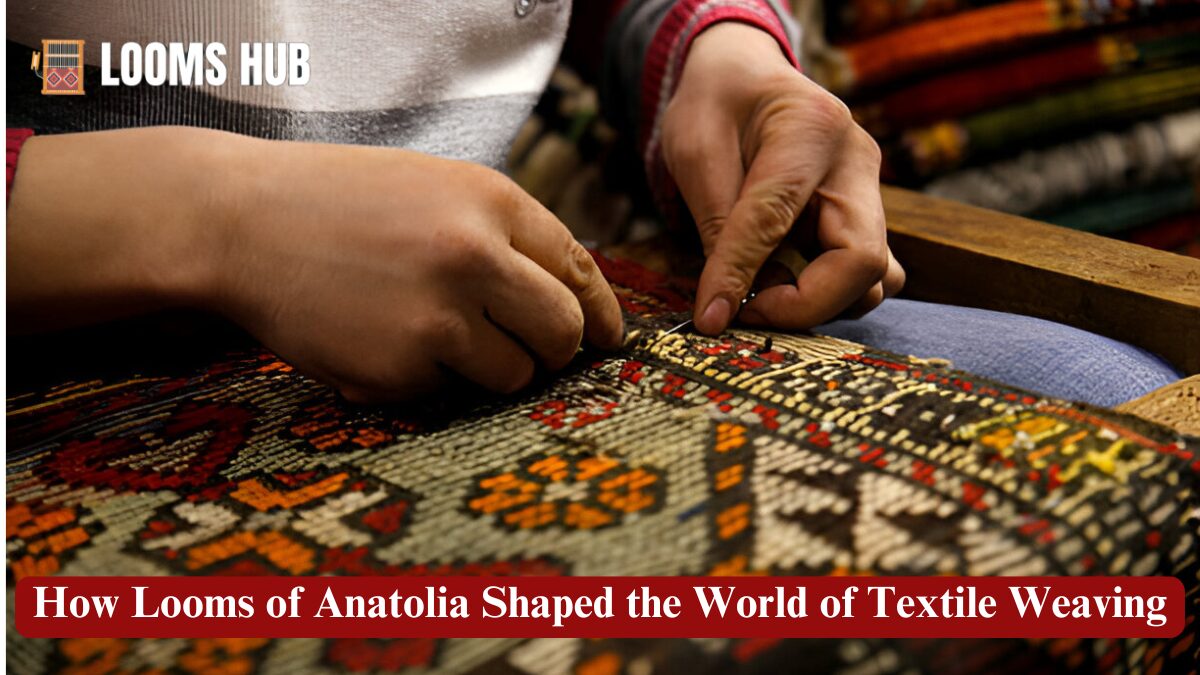The looms of Anatolia have played a significant role in the textile industry for centuries, contributing to some of the most exquisite woven fabrics and rugs in the world. These looms, deeply rooted in history, have sustained cultural traditions while also adapting to modern advancements. This article explores the history, craftsmanship, techniques, materials, and future of Anatolian looms.
The Historical Roots of Anatolian Looms
Ancient Origins of Weaving in Anatolia
Anatolia, the land bridge between Asia and Europe, has been home to some of the earliest known weaving traditions. Archaeological evidence from Çatalhöyük, an ancient Neolithic site in Turkey, suggests that weaving techniques date back over 8,000 years. These early weavers used rudimentary looms to create fabrics from natural fibers, setting the foundation for Anatolian textile arts.
Influence of the Silk Road on Anatolian Weaving
The Silk Road was instrumental in shaping the weaving traditions of Anatolia. As a major crossroads for trade, Anatolia absorbed influences from China, Persia, and Central Asia. This exchange enriched Anatolian weaving, introducing intricate patterns, silk threads, and dyeing techniques that elevated the artistry of local looms.
The Role of Anatolian Looms in Ottoman Trade
During the Ottoman Empire, weaving became a thriving industry. The Ottomans commissioned master weavers to create luxurious rugs and textiles for palaces, mosques, and international trade. Many of these carpets, adorned with floral and geometric motifs, became sought-after treasures across Europe and Asia, securing Anatolia’s reputation as a weaving powerhouse.
Traditional Looms of Anatolia
The Warp-Weighted Loom: An Ancient Tool
The warp-weighted loom is one of the oldest types of looms used in Anatolia. This vertical loom relies on gravity, with heavy clay or stone weights keeping the warp threads taut. It was commonly used by early Anatolian weavers to create simple but durable textiles.
Horizontal Ground Looms and Their Evolution
The horizontal ground loom, widely used by nomadic tribes, is another fundamental weaving tool. This loom allowed for portability and easy setup, enabling traveling artisans to craft carpets and kilims as they moved across the Anatolian plains.
Vertical Looms: Precision Weaving in Anatolia
Vertical looms, particularly high and low-warp varieties, became essential for weaving intricate Anatolian rugs. These looms enabled artisans to weave complex patterns with greater precision, making them ideal for producing detailed floral and geometric designs.
The Art of Weaving in Anatolia
Techniques Passed Down Generations
Anatolian weaving techniques have been meticulously passed from one generation to the next. Master weavers train apprentices, ensuring that traditional skills, such as the double knot (Gördes knot) technique, remain alive.
Unique Hand-Knotted Styles of Anatolian Rugs
Hand-knotted rugs, particularly those using the symmetrical Turkish knot, are a hallmark of Anatolian craftsmanship. This knotting technique results in dense, durable carpets that are known for their longevity and vibrant designs.
Symbolism in Anatolian Textile Designs
Anatolian textiles often incorporate symbols representing fertility, protection, and prosperity. For instance, the Tree of Life motif signifies immortality, while the ram’s horn symbolizes strength and power. These motifs give each piece a deeper cultural meaning.
Materials Used in Anatolian Weaving
Natural Wool and Its Importance
Sheep wool is the most commonly used fiber in Anatolian weaving. Sourced from local sheep breeds, it provides warmth, durability, and excellent dye absorption.
Silk Weaving: A Luxury of Anatolian Craftsmanship
Silk weaving became prominent in the Ottoman period, with cities like Bursa becoming renowned for silk production. Anatolian silk rugs are considered premium products due to their fine texture and intricate detailing.
Vegetable Dyes and Natural Pigments
Traditional Anatolian weavers use natural dyes from plants, roots, and insects to color their fabrics. Common dyes include madder (red), indigo (blue), and walnut husk (brown), which produce rich, long-lasting hues.
Famous Anatolian Rugs in History
The Pazyryk Carpet: A Link to Anatolian Craft
The Pazyryk carpet, found in a Scythian burial mound, is believed to have Anatolian influences, demonstrating the deep historical connections of the region’s weaving traditions.
Ottoman Court Rugs and Their Intricate Patterns
During the Ottoman period, exquisite court rugs were woven for royal households. These carpets featured elaborate floral motifs, silk threads, and gold-wrapped fibers.
Anatolian Carpets in European Palaces and Museums
Anatolian carpets were highly prized in Europe, decorating palaces and churches. Today, many of these masterpieces can be found in museums such as the Louvre and the Metropolitan Museum of Art.
Challenges Faced by Weaving Communities
Declining Interest in Traditional Weaving
The younger generation’s shift towards modern industries has led to a decline in interest in traditional weaving, threatening the survival of this ancient craft.
Competition from Mass-Produced Carpets
Machine-made carpets, which are cheaper and faster to produce, have overshadowed handwoven Anatolian rugs, making it difficult for artisans to compete.
Environmental Challenges in Wool and Dye Production
Climate change and industrial pollution have affected wool production and natural dye sources, posing further challenges for Anatolian weavers.
Preserving the Legacy of Anatolian Looms
Government and NGO Efforts to Protect Hand Weaving
Several organizations, including UNESCO and local Turkish initiatives, are working to preserve Anatolian weaving traditions through educational programs and heritage protection.
Training the Next Generation of Weavers
Vocational training centers have been established to teach young artisans the skills needed to sustain Anatolian weaving traditions.
Digital Innovations to Archive and Document Traditional Weaving
Technology is being used to document weaving patterns and techniques, ensuring that the knowledge is preserved for future generations.
Conclusion
Anatolian looms represent a deep cultural and historical legacy. They have shaped the global textile industry and continue to be revered for their craftsmanship and artistry. Despite challenges, efforts to preserve these traditions remain strong, ensuring that the beauty of Anatolian weaving will endure for generations to come.
FAQs
- What makes Anatolian looms unique?
- Anatolian looms use the symmetrical Turkish knot, natural dyes, and traditional motifs, making them distinct from other weaving traditions.
- How old is Anatolian weaving?
- Anatolian weaving dates back over 8,000 years, with roots in Neolithic settlements like Çatalhöyük.
- What are the most famous Anatolian rugs?
- Konya rugs, Bergama rugs, and Hereke silk carpets are some of the most well-known Anatolian rugs.
- How can I tell if an Anatolian rug is handmade?
- Handmade Anatolian rugs have visible knots, slight irregularities, and a dense texture compared to machine-made ones.
- Are Anatolian rugs expensive?
- Yes, due to their craftsmanship, natural materials, and time-intensive production, they can be costly.
- Why are natural dyes preferred in Anatolian textiles?
- Natural dyes produce vibrant, long-lasting colors that develop a beautiful patina over time.
- What is the difference between Turkish and Persian knots?
- Turkish knots are symmetrical and durable, while Persian knots are asymmetrical and allow for finer details.
- Where can I buy authentic Anatolian carpets?
- Trusted sources include Turkish marketplaces, artisan cooperatives, and reputable online dealers.
- How is Anatolian weaving being preserved?
- Government initiatives, NGOs, and educational programs actively preserve traditional weaving techniques.
- Can Anatolian weaving be adapted for modern designs?
- Yes, many contemporary designers integrate traditional Anatolian patterns into modern home decor styles.



